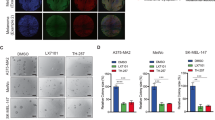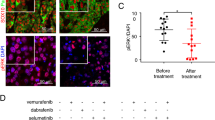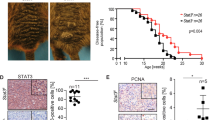Abstract
One of the defining features of aggressive melanomas is their complexity. Hundreds of mutations and an ever increasing list of changes in the transcriptome and proteome distinguish normal from malignant melanocytic cells. Yet, despite this altered genetic background, a long-known attribute of melanomas is a relatively low rate of mutations in the p53 gene. However, it is unclear whether p53 is maintained in melanoma cells because it is required for their survival, or because it is functionally disabled. More pressing from a translational perspective, is to define whether there is a tumor cell-selective wiring of p53 that offers a window for therapeutic intervention. Here, we provide genetic and pharmacological evidence demonstrating that p53 represents a liability to melanoma cells, which they thwart by assuming an oncogenic dependency on the E3 ligase murine double minute-2 (MDM2). Specifically, we used a combination of RNA interference and two structurally independent small molecule inhibitors of the p53–MDM2 interaction to assess the relative requirement of both proteins for the viability of normal melanocytes and a broad panel of melanoma cell lines. We demonstrated in vitro and in vivo that MDM2 is selectively required to blunt latent pro-senescence signals in melanoma cells. Notably, the outcome of MDM2 inactivation depends not only on the mutational status of p53, but also on its ability to signal to the transcription factor E2F1. These data support MDM2 as a drug target in melanoma cells, and identify E2F1 as a biomarker to consider when stratifying putative candidates for clinical studies of p53–MDM2 inhibitors.
This is a preview of subscription content, access via your institution
Access options
Subscribe to this journal
Receive 50 print issues and online access
$259.00 per year
only $5.18 per issue
Buy this article
- Purchase on Springer Link
- Instant access to full article PDF
Prices may be subject to local taxes which are calculated during checkout







Similar content being viewed by others
Accession codes
References
Ambrosini G, Sambol EB, Carvajal D, Vassilev LT, Singer S, Schwartz GK . (2007). Mouse double minute antagonist Nutlin-3a enhances chemotherapy-induced apoptosis in cancer cells with mutant p53 by activating E2F1. Oncogene 26: 3473–3481.
Avery-Kiejda KA, Zhang XD, Adams LJ, Scott RJ, Vojtesek B, Lane DP et al. (2008). Small molecular weight variants of p53 are expressed in human melanoma cells and are induced by the DNA-damaging agent cisplatin. Clin Cancer Res 14: 1659–1668.
Bardeesy N, Bastian BC, Hezel A, Pinkel D, DePinho RA, Chin L . (2001). Dual inactivation of RB and p53 pathways in RAS-induced melanomas. Mol Cell Biol 21: 2144–2153.
Bartkova J, Horejsi Z, Koed K, Kramer A, Tort F, Zieger K et al. (2005). DNA damage response as a candidate anti-cancer barrier in early human tumorigenesis. Nature 434: 864–870.
Bennett DC . (2008). How to make a melanoma: what do we know of the primary clonal events? Pigment Cell Melanoma Res 21: 27–38.
Campanero MR, Flemington EK . (1997). Regulation of E2F through ubiquitin-proteasome-dependent degradation: stabilization by the pRB tumor suppressor protein. Proc Natl Acad Sci USA 94: 2221–2226.
Castresana JS, Rubio MP, Vazquez JJ, Idoate M, Sober AJ, Seizinger BR et al. (1993). Lack of allelic deletion and point mutation as mechanisms of p53 activation in human malignant melanoma. Int J Cancer 55: 562–565.
Denoyelle C, Abou-Rjaily G, Bezrookove V, Verhaegen M, Johnson TM, Fullen DR et al. (2006). Anti-oncogenic role of the endoplasmic reticulum differentially activated by mutations in the MAPK pathway. Nat Cell Biol 8: 1053–1063.
Fernandez Y, Verhaegen M, Miller TP, Rush JL, Steiner P, Opipari Jr AW et al. (2005). Differential regulation of noxa in normal melanocytes and melanoma cells by proteasome inhibition: therapeutic implications. Cancer Res 65: 6294–6304.
Fu W, Ma Q, Chen L, Li P, Zhang M, Ramamoorthy S et al. (2009). MDM2 acts downstream of p53 as an E3 ligase to promote FOXO ubiquitination and degradation. J Biol Chem 284: 13987–14000.
Gray-Schopfer V, Wellbrock C, Marais R . (2007). Melanoma biology and new targeted therapy. Nature 445: 851–857.
Ha L, Ichikawa T, Anver M, Dickins R, Lowe S, Sharpless NE et al. (2007). ARF functions as a melanoma tumor suppressor by inducing p53-independent senescence. Proc Natl Acad Sci USA 104: 10968–10973.
Hoek KS . (2007). DNA microarray analyses of melanoma gene expression: a decade in the mines. Pigment Cell Res 20: 466–484.
Hofmann F, Martelli F, Livingston DM, Wang Z . (1996). The retinoblastoma gene product protects E2F-1 from degradation by the ubiquitin-proteasome pathway. Genes Dev 10: 2949–2959.
Hu B, Gilkes DM, Farooqi B, Sebti SM, Chen J . (2006). MDMX overexpression prevents p53 activation by the MDM2 inhibitor Nutlin. J Biol Chem 281: 33030–33035.
Huang B, Deo D, Xia M, Vassilev LT . (2009). Pharmacologic p53 activation blocks cell cycle progression but fails to induce senescence in epithelial cancer cells. Mol Cancer Res 7: 1497–1509.
Jemal A, Siegel R, Xu J, Ward E . (2010). Cancer statistics, 2010. CA Cancer J Clin 60: 277–300.
Kass EM, Poyurovsky MV, Zhu Y, Prives C . (2009). Mdm2 and PCAF increase Chk2 ubiquitination and degradation independently of their intrinsic E3 ligase activities. Cell Cycle 8: 430–437.
Korotchkina LG, Demidenko ZN, Gudkov AV, Blagosklonny MV . (2009). Cellular quiescence caused by the Mdm2 inhibitor nutlin-3A. Cell Cycle 8: 3777–3781.
Kumamoto K, Spillare EA, Fujita K, Horikawa I, Yamashita T, Appella E et al. (2008). Nutlin-3a activates p53 to both down-regulate inhibitor of growth 2 and up-regulate mir-34a, mir-34b, and mir-34c expression, and induce senescence. Cancer Res 68: 3193–3203.
Long J, Parkin B, Ouillette P, Bixby D, Shedden K, Erba H et al. (2010). Multiple distinct molecular mechanisms influence sensitivity and resistance to MDM2 inhibitors in adult acute myelogenous leukemia. Blood 116: 71–80.
Michaloglou C, Vredeveld LC, Soengas MS, Denoyelle C, Kuilman T, van der Horst CM et al. (2005). BRAFE600-associated senescence-like cell cycle arrest of human naevi. Nature 436: 720–724.
Moran DM, Maki CG . (2010). Nutlin-3a induces cytoskeletal rearrangement and inhibits the migration and invasion capacity of p53 wild-type cancer cells. Mol Cancer Ther 9: 895–905.
Murga M, Bunting S, Montana MF, Soria R, Mulero F, Canamero M et al. (2009). A mouse model of ATR-Seckel shows embryonic replicative stress and accelerated aging. Nat Genet 41: 891–898.
Nikiforov MA, Riblett M, Tang WH, Gratchouck V, Zhuang D, Fernandez Y et al. (2007). Tumor cell-selective regulation of NOXA by c-MYC in response to proteasome inhibition. Proc Natl Acad Sci USA 104: 19488–19493.
Patton EE, Widlund HR, Kutok JL, Kopani KR, Amatruda JF, Murphey RD et al. (2005). BRAF mutations are sufficient to promote nevi formation and cooperate with p53 in the genesis of melanoma. Curr Biol 15: 249–254.
Polager S, Ginsberg D . (2009). p53 and E2f: partners in life and death. Nat Rev Cancer 9: 738–748.
Polsky D, Cordon-Cardo C . (2003). Oncogenes in melanoma. Oncogene 22: 3087–3091.
Pommier Y, Sordet O, Antony S, Hayward RL, Kohn KW . (2004). Apoptosis defects and chemotherapy resistance: molecular interaction maps and networks. Oncogene 23: 2934–2949.
Prieur A, Peeper DS . (2008). Cellular senescence in vivo: a barrier to tumorigenesis. Curr Opin Cell Biol 20: 150–155.
Ryan KM, Phillips AC, Vousden KH . (2001). Regulation and function of the p53 tumor suppressor protein. Curr Opin Cell Biol 13: 332–337.
Satyamoorthy K, Chehab NH, Waterman MJ, Lien MC, El-Deiry WS, Herlyn M et al. (2000). Aberrant regulation and function of wild-type p53 in radioresistant melanoma cells. Cell Growth Differ 11: 467–474.
Sdek P, Ying H, Chang DL, Qiu W, Zheng H, Touitou R et al. (2005). MDM2 promotes proteasome-dependent ubiquitin-independent degradation of retinoblastoma protein. Mol Cell 20: 699–708.
Shangary S, Qin D, McEachern D, Liu M, Miller RS, Qiu S et al. (2008). Temporal activation of p53 by a specific MDM2 inhibitor is selectively toxic to tumors and leads to complete tumor growth inhibition. Proc Natl Acad Sci USA 105: 3933–3938.
Shangary S, Wang S . (2009). Small-molecule inhibitors of the MDM2-p53 protein-protein interaction to reactivate p53 function: a novel approach for cancer therapy. Annu Rev Pharmacol Toxicol 49: 223–241.
Shen H, Moran DM, Maki CG . (2008). Transient nutlin-3a treatment promotes endoreduplication and the generation of therapy-resistant tetraploid cells. Cancer Res 68: 8260–8268.
Smalley KS, Contractor R, Haass NK, Kulp AN, Atilla-Gokcumen GE, Williams DS et al. (2007). An organometallic protein kinase inhibitor pharmacologically activates p53 and induces apoptosis in human melanoma cells. Cancer Res 67: 209–217.
Soengas MS, Capodieci P, Polsky D, Mora J, Esteller M, Opitz-Araya X et al. (2001). Inactivation of the apoptosis effector Apaf-1 in malignant melanoma. Nature 409: 207–211.
Soengas MS, Lowe SW . (2003). Apoptosis and melanoma chemoresistance. Oncogene 22: 3138–3151.
Terzian T, Torchia EC, Dai D, Robinson SE, Murao K, Stiegmann RA et al. (2010). p53 prevents progression of nevi to melanoma predominantly through cell cycle regulation. Pigment Cell Melanoma Res 23: 781–794.
Vassilev LT . (2007). MDM2 inhibitors for cancer therapy. Trends Mol Med 13: 23–31.
Vazquez A, Bond EE, Levine AJ, Bond GL . (2008). The genetics of the p53 pathway, apoptosis and cancer therapy. Nat Rev Drug Discov 7: 979–987.
Verhaegen M, Bauer JA, Martin de la Vega C, Wang G, Wolter KG, Brenner JC et al. (2006). A novel BH3 mimetic reveals a mitogen-activated protein kinase-dependent mechanism of melanoma cell death controlled by p53 and reactive oxygen species. Cancer Res 66: 11348–11359.
Verma R, Rigatti MJ, Belinsky GS, Godman CA, Giardina C . (2010). DNA damage response to the Mdm2 inhibitor nutlin-3. Biochem Pharmacol 79: 565–574.
Vousden KH, Prives C . (2009). Blinded by the light: the growing complexity of p53. Cell 137: 413–431.
Wade M, Wang YV, Wahl GM . (2010). The p53 orchestra: Mdm2 and Mdmx set the tone. Trends Cell Biol 20: 299–309.
Xiao ZX, Chen J, Levine AJ, Modjtahedi N, Xing J, Sellers WR et al. (1995). Interaction between the retinoblastoma protein and the oncoprotein MDM2. Nature 375: 694–698.
Yang G, Zhang G, Pittelkow MR, Ramoni M, Tsao H . (2006). Expression profiling of UVB response in melanocytes identifies a set of p53-target genes. J Invest Dermatol 126: 2490–2506.
Zhang Z, Wang H, Li M, Agrawal S, Chen X, Zhang R . (2004). MDM2 is a negative regulator of p21WAF1/CIP1, independent of p53. J Biol Chem 279: 16000–16006.
Zhu Y, Poyurovsky MV, Li Y, Biderman L, Stahl J, Jacq X et al. (2009). Ribosomal protein S7 is both a regulator and a substrate of MDM2. Mol Cell 35: 316–326.
Acknowledgements
We thank Joshua A Bauer, J Chadwick Brenner and Thomas E Carey for shRNA constructs against p53 and MDM2, Andrzej Dlugosz for support and Mikhail Nikiforov for helpful suggestions at early stages of this study. MSS was supported by R01CA107237 from the NIH, SAF2008-01950 from the Spanish Ministry of Science and Innovation, and a development grant from the Spanish Association Against Cancer (AECC). SW was funded by R01CA121279 and MV is the recipient of a Career Development Award from the Dermatology Foundation.
Author information
Authors and Affiliations
Corresponding author
Ethics declarations
Competing interests
The p53–MDM2-binding inhibitor MI-219 was licensed by the University of Michigan to Ascenta Therapeutics Inc. (Malvern, PA, USA), and has been subsequently sub-licensed to Sanofi-Aventis (Bridgewater, NJ, USA). Shaomeng Wang owns stocks and serves as a consultant in Ascenta Therapeutics. The University of Michigan also owns stocks in Ascenta Therapeutics and receives milestone and royalty payments from Ascenta and Sanofi-Aventis.
Additional information
Supplementary Information accompanies the paper on the Oncogene website
Supplementary information
Rights and permissions
About this article
Cite this article
Verhaegen, M., Checinska, A., Riblett, M. et al. E2F1-dependent oncogenic addiction of melanoma cells to MDM2. Oncogene 31, 828–841 (2012). https://doi.org/10.1038/onc.2011.277
Received:
Revised:
Accepted:
Published:
Issue Date:
DOI: https://doi.org/10.1038/onc.2011.277
Keywords
This article is cited by
-
Lysosomal trapping of palbociclib and its functional implications
Oncogene (2019)
-
E2F1 inhibition mediates cell death of metastatic melanoma
Cell Death & Disease (2018)
-
HEDGEHOG/GLI-E2F1 axis modulates iASPP expression and function and regulates melanoma cell growth
Cell Death & Differentiation (2015)
-
Transcription addiction: can we garner the Yin and Yang functions of E2F1 for cancer therapy?
Cell Death & Disease (2014)
-
FK506 binding protein 51 positively regulates melanoma stemness and metastatic potential
Cell Death & Disease (2013)



